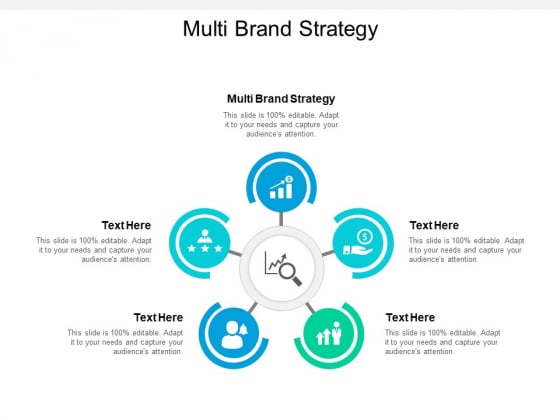Multi Brand Strategy: The Best Way to Grow Your Business Globally in 2024

adopting a multi-brand strategy is increasingly recognized as an effective way to expand your business on a global scale. This approach involves operating several brands under one umbrella, each tailored to different market segments and consumer needs. By diversifying offerings and targeting specific demographics, businesses can mitigate risks, maximize market coverage, and tap into varied customer preferences.
This strategy not only allows for customized marketing approaches and product development but also provides a safety net against market volatility. In this blog, we’ll explore how a multi-brand strategy can drive growth and enhance a company's presence in international markets.
What is a Multi-brand Strategy?

A multi-brand strategy is a marketing and business approach where a company or organization offers multiple distinct brands or product lines within the same market or industry. Each of these brands is positioned differently and caters to a specific target audience, even though they may be owned by the same parent company. The key idea behind a multi-brand strategy is to diversify a company's product or service offerings and capture a broader share of the market.
Why is a Multi-brand Strategy Important for Global Growth?
A multi-brand strategy is vital for global growth because it allows a company to:
- Adapt to Local Markets: Tailor products to specific market preferences and cultures.
- Diversify and Reduce Risk: Operate multiple brands to mitigate risks and financial exposure.
- Leverage Trusted Brands: Use established brands to gain trust and recognition in new markets.
- Reach a Wider Audience: Target diverse customer segments more effectively.
- Comply with Regulations: Navigate varying global regulations more easily.
- Prevent Internal Competition: Avoid competing with your own products.
- Adapt to Market Changes: Be responsive to shifts in global markets.
- Facilitate Market Entry: Simplify entry into new markets with tailored brands.
- Drive Innovation: Focus on innovation in different areas to stay competitive.
- Diversify the Portfolio: Create stability by balancing successes and challenges globally.
Benefits of Multi-brand Strategy
There are many benefits to using a multi-brand strategy, including:
- Increased market share: A multi-product branding strategy allows companies to target different market segments with different brands. This can lead to increased market share in each market, as well as overall market share.
- Reduced risk: A multi-brand strategy can reduce risk by diversifying a company's product portfolio and customer base. This means that if one brand underperforms in a particular market, the other brands can help to offset the losses.
- Increased brand awareness: A multi-brand strategy can help to increase brand awareness in new markets. This is because consumers are more likely to be aware of a brand that has multiple products and services available.
- Improved brand image: A multi-brand strategy can help to improve a company's overall brand image. This is because consumers are more likely to perceive a company as being innovative and successful if it has multiple successful brands.
- Adapt to local cultures and preferences: A multi-brand strategy allows companies to adapt their products and services to the specific cultures and preferences of different markets. This can be essential for success in global markets.
- Respond to local competitors: A multi-brand strategy allows companies to respond to local competitors more effectively. For example, if a local competitor launches a new product, a company with a multi brand strategy can quickly launch a similar product under a different brand.
- Build a stronger brand portfolio: A multi-brand strategy can help companies to build a stronger brand portfolio. This can make the company more attractive to investors and potential acquirers.
Single brand vs Multi-brand Strategy

Here is the explanation for the single and multi-brand strategy:
Single brand strategy
A single brand strategy is a business strategy in which a company has only one brand. This brand is used for all of the company's products and services.
Multi-brand strategy
A multi-brand strategy is a new brand strategy in which a company owns and manages multiple brands. Each brand has its own unique identity and targets a different market segment.
Benefits of a single brand strategy
- Consistency: A single brand strategy can help to create a consistent customer experience across all of the company's products and services.
- Efficiency: A single-brand strategy can be more efficient than a multi-brand strategy because the company only needs to manage one brand.
- Focus: A single brand strategy can help the company to focus on building one strong brand.
Benefits of a multi-brand strategy
- Reach a wider audience: A multi-brand strategy allows the company to reach a wider audience by targeting different market segments with different brands.
- Reduce risk: A multi-brand strategy can reduce risk by diversifying the company's product portfolio and customer base.
- Build a stronger brand portfolio: A multi-brand strategy can help the company to build a stronger brand portfolio. This can make the company more attractive to investors and potential acquirers.
Which strategy is right for you?
The best strategy for your company will depend on several factors, including your target market, your products and services, and your budget. If you are targeting a single market segment with a limited number of products and services, a single brand strategy may be the best option. If you are targeting multiple market segments with a wide range of products and services, a multi-brand strategy may be the better option.
How to develop a multi-brand strategy for global growth?
To develop a multi-brand strategy for global growth, you should follow these steps:
- Define your target markets and goals. What are your specific goals for global growth? What are the key markets you want to enter? Once you have a clear understanding of your goals, you can start to identify the target markets that are most likely to help you achieve those goals.
- Research your target markets. Once you have identified your target markets, you need to research them in depth. This includes understanding their needs and preferences, as well as the competitive landscape in each market.
- Develop unique brand identities for each market. Each of your brands should have its own unique identity that resonates with your target market in that market. This includes developing unique brand names, logos, messaging, and product offerings.
- Choose the right distribution channels for each market. How will you get your products to your target customers in each market? You will need to choose the distribution channels that are most effective in each market. This may include online channels, offline channels, or a combination of both.
- Market your brands to your target markets. Once you have your products in place in each market, you need to market your brands to your target customers. This may include advertising, public relations, and social media marketing.
Ghost Commerce Strategy: The Future of Ecommerce
Examples of Successful Multi-brand Strategies for Global Growth

Here are some multi-brand strategy examples for global growth:
- Unilever: Unilever is a global consumer goods company that owns over 400 brands, including Dove, Axe, and Ben & Jerry's. Unilever's multi-brand strategy has allowed the company to expand into over 190 countries and achieve global market leadership in many categories.
- Procter & Gamble: Procter & Gamble is another global consumer goods company that owns over 60 brands, including Tide, Pampers, and Gillette. Procter & Gamble's multi-brand strategy has allowed the company to expand into over 180 countries and achieve global market leadership in many categories.
- Nestlé: Nestlé is a global food and beverage company that owns over 2,000 brands, including KitKat, Nescafé, and Nespresso. Nestlé's multi-brand strategy has allowed the company to expand into over 190 countries and achieve global market leadership in many categories.
- Coca-Cola: Coca-Cola is a global beverage company that owns over 500 brands, including Coca-Cola, Sprite, and Fanta. Coca-Cola's multi-brand marketing strategy has allowed the company to expand into over 200 countries and achieve global market leadership in many categories.
- PepsiCo: PepsiCo is a global food and beverage company that owns over 22 brands, including Pepsi-Cola, Doritos, and Gatorade. PepsiCo's multi-brand strategy has allowed the company to expand into over 200 countries and achieve global market leadership in many categories.
How to use AI tools in a Multi-brand Strategy?
Implementing a multi-brand strategy can be a powerful approach to expanding your business globally. By segmenting your offerings and targeting different market niches, you're better equipped to cater to diverse consumer preferences. But in today's fast-paced business world, technology plays a crucial role in optimizing this strategy.
AI-powered tools like Manifest AI, for instance, have become invaluable assets for companies looking to scale their multi-brand approach efficiently. These tools offer data-driven insights, help optimize product listings, and provide a competitive edge by identifying trends and consumer behaviors across different markets. In a global business landscape, where responsiveness and data-driven decision-making are paramount, integrating AI solutions like Manifest AI can make your multi-brand strategy even more effective.
Advantages and Disadvantages of multi-brand strategy
Here are the advantages & disadvantages of a Multi-brand strategy:
Advantages of a multi-brand strategy
- Market diversification: A multi-brand strategy can help a company enter new markets and reach a wider range of customers. This can be particularly beneficial for companies that operate in cyclical industries, as it can help them to reduce their risk and maintain a more steady stream of revenue.
- Product differentiation: A multi-brand strategy can help a company to differentiate its products and services from those of its competitors. This can be achieved by creating brands that appeal to different customer segments or that offer different types of products and services.
- Brand equity: A multi-brand strategy can help a company to build brand equity. This is because each brand can develop its own unique identity and following. If one brand is unsuccessful, it will not necessarily damage the reputation of the company's other brands.
- Acquisition opportunities: A multi-brand strategy can make a company more attractive to potential acquirers. This is because acquirers may be interested in acquiring the company's individual brands, even if they are not interested in acquiring the entire company.
Disadvantages of a multi-brand strategy
- Cost: A multi-brand strategy can be more costly to maintain than a single-brand strategy. This is because each brand requires its own marketing and advertising budget.
- Complexity: A multi-brand strategy can be more complex to manage than a single-brand strategy. This is because each brand requires its own unique marketing and branding strategy.
- Cannibalization: A multi-brand strategy can lead to brand cannibalization, which occurs when a company's own brands compete with each other for market share. This can be avoided by carefully differentiating the company's brands and by targeting them to different customer segments.
Challenges of implementing a multi-brand strategy for global growth
There are a number of challenges that companies face when implementing a multi-brand strategy for global growth. Some of the key challenges include:
- Managing multiple brands: Managing company with multiple brands can be complex and challenging. Companies need to ensure that each brand has its own unique identity and that the brands are consistent across all markets.
- Coordinating marketing efforts across markets: It can be difficult to coordinate marketing efforts across multiple markets. Companies need to ensure that their marketing campaigns are consistent and effective in each market.
- Ensuring brand consistency across markets: It is important to ensure that your brands are consistent across all markets. This means that your brand identities, product offerings, and marketing campaigns should be similar in each market.
- Adapting to local cultures and preferences: Companies need to adapt their brands to the specific cultures and preferences of each market. This may include making changes to your brand identities, product offerings, and marketing campaigns in each market.
- Overcoming language barriers: Language barriers can be a challenge for companies that are operating in multiple markets. Companies need to ensure that their brands and marketing materials are translated accurately into the local languages of each market.
- Complying with local regulations: Companies need to comply with the local regulations of each market in which they operate. This can be complex and challenging, especially in markets with strict regulations.
Tips for overcoming the challenges of a multi-brand strategy for global growth
Here are some tips for overcoming the challenges of a multi-brand strategy for global growth:
- Invest in strong brand management. A multi-brand strategy requires a strong brand management team to ensure that each brand has its own unique identity and that the brands are consistent across all markets. This team should be responsible for developing and implementing brand strategies, as well as overseeing brand performance.
- Use a centralized marketing team to coordinate marketing efforts across markets. A centralized marketing team can help to ensure that marketing campaigns are consistent and effective across all markets. This team can also help coordinate marketing activities with local teams to ensure that they are tailored to the specific needs of each market.
- Develop a global brand strategy that can be adapted to local markets. A global brand strategy should be flexible enough to be adapted to the specific needs and preferences of each local market. This means that companies may need to make some changes to their brand identities, product offerings, and marketing campaigns in each market.
- Invest in localization. Localization is the process of adapting products and services to the specific needs and preferences of a particular market. This includes translating marketing materials into local languages and adapting imagery and messaging to resonate with local consumers.
- Partner with local experts. Partnering with local experts can be a great way to gain insights into the local market and to ensure that brands and marketing efforts are compliant with local regulations. Local experts can also provide valuable assistance with product development, marketing, and sales.
Conclusion
In conclusion, a multi-brand strategy is an essential tool for companies that seek to achieve global growth. By tailoring their products and services to the specific needs and preferences of different consumer segments in different markets, companies can increase their market share, reduce risk, improve brand awareness, and build a stronger brand portfolio.

.png)
